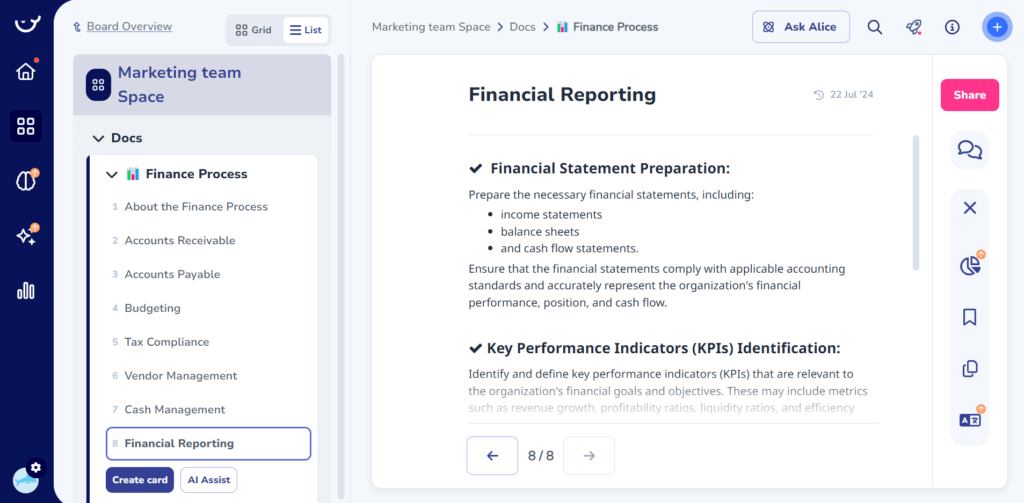
What are the 4 types of financial reporting?
Financial reporting consists of four primary types of financial statements, each offering a unique perspective on a company’s financial health:
1. Balance Sheet
Overview: Provides a snapshot of a company’s assets, liabilities, and shareholders’ equity at a specific point in time, detailing what the company owns and owes.
Components:
- Assets: Includes current assets (cash, inventory, accounts receivable) and non-current assets (property, equipment, patents).
- Liabilities: Lists all outstanding debts and obligations.
- Equity: Represents the residual interest in the assets after deducting liabilities.
- Usage:
- Internal: Helps business leaders and employees assess company performance and make strategic decisions.
- External: Assists investors and regulators in evaluating the company’s financial position.
2. Income Statement
Overview: Also known as the profit and loss statement, it outlines revenues, expenses, and profits over a period.
Components:
- Revenue: Total income generated
- Expenses: Costs incurred, including COGS (cost of goods sold).
- Profit Metrics: Gross profit, operating income, net income, and earnings per share.
Usage: Provides insight into the company’s operational efficiency and profitability, guiding investors and stakeholders.
3. Cash Flow Statement
Overview: Shows how cash is generated and used during a period, offering a detailed view of cash inflows and outflows.
Components:
- Operating Activities: Cash from regular business operations.
- Investing Activities: Cash from buying or selling assets.
- Financing Activities: Cash from debt or equity financing.
Methods:
- Direct: Lists actual cash transactions.
- Indirect: Adjusts net income for non-cash items.
Usage: Evaluates the company’s liquidity and financial flexibility.
4. Statement of Shareholders’ Equity
- Overview: Details changes in the equity portion of the balance sheet over a period.
- Components:
- Common and Preferred Stock: Equity stakes with different rights.
- Retained Earnings: Profits reinvested in the company.
- Treasury Stock: Repurchased shares.
- Additional Paid-Up Capital: Excess amount over par value paid by investors.
- Unrealized Gains/Losses: Value changes in investments not yet sold.
- Usage: Informs investors about equity changes and company performance, aiding investment decisions.
Financial statements are typically prepared monthly, quarterly, or annually, depending on company goals and regulatory requirements. Some companies may combine statements, such as including the statement of shareholders’ equity within the balance sheet.
Use our templates to fast-track your documentation
Customize this template and 100s of others for free in Whale, the fastest way to get your team aligned.
How do you structure a finance report?
Here we’ve outlined how you can structure your template finance report in 5 steps:
1. Write a Company Description and Overview
Begin with a brief synopsis of the business and the industry it operates in. Highlight any significant events, milestones, or achievements from the past year. This section can also acknowledge notable contributions from individual employees or department supervisors. Using a financial report template in Excel can streamline this process, ensuring consistency and accuracy in reporting.
2. Include a Letter from the CEO
This section features a direct letter from the CEO or business owner. The tone should be professional yet approachable. The CEO can use the letter to discuss what happened this year, thank those who helped, and share plans for the future. Key elements to include:
- Address unexpected challenges and how they were overcome.
- Thank employees, managers, stockholders, and donors.
- Discuss future performance expectations and actionable goals.
3. Include Data
This is the core of the financial report, presenting a comprehensive financial examination of the past year. It should include:
- Balance Sheet
- Income Statement
- Cash Flow Statement
- Statement of Shareholders’ Equity
4. Outline the Company’s Management
List key managers, supervisors, and officers along with their titles. Note any changes in the management structure or roles that impacted the business. Providing detailed information about the management team adds transparency and builds trust with stakeholders.
5. Write the Footnotes
Include footnotes to clarify any elements in the report that require further explanation. This enhances transparency and addresses potential questions from stakeholders. Footnotes can cover special considerations, terms, or conditions related to the financial information presented.

What are the 5 steps of financial reporting?
To effectively perform financial analyzing, businesses can follow these five steps:
1. Comparison Between Forecast and Actual Monthly Results
Regularly reviewing finances is essential. To maximize the benefits, compare forecasted results with actual outcomes. This comparison helps track progress and identify areas needing improvement by aligning monthly plans with accounting software reports.
2. Identify Exceeding Projections or Off-Track Performance
Forecasting involves making educated predictions, and actual performance may differ. Identifying whether performance exceeds or falls short of projections allows businesses to take corrective actions and adjust strategies accordingly.
3. Review Income and Expenses
The income statement, or profit and loss statement, offers a snapshot of financial performance. Comparing this statement with the forecast helps businesses assess goal achievement, sales targets, and budget adherence. This comparison is vital for informed decision-making and growth.
4. Analyze Cash Flow Statement
Understanding cash flow is crucial. Comparing the cash flow statement with the forecast reveals if the business is on track. This guides necessary corrective actions and helps manage the company’s bank balance according to plan.
5. Review Balance Sheet
The balance sheet provides a comprehensive view of the company’s financial position, detailing assets and liabilities. Analyzing it helps see how well customers pay their debts, making sure the business stays on budget.
Businesses can use a financial summary report template to efficiently analyze finances, track progress, and make informed decisions for growth.
NetSuite on What is Financial Reporting?
Financial Reporting Use Cases
Perhaps you need financial reporting for your accountant or tax purposes, but did you know financial reporting can also be used by;
- By potential investors who are considering buying stock in a company.
- For banks’ analyses of credit applications for loans, lines of credit and letters of credit for overseas activity.
- By credit card issuers evaluating a corporate or business credit card application.
- For potential merger or acquisition activity.
- For bargaining with labor unions.
- For senior management, to analyze profitability at all levels: consolidated, by subsidiary, by location and by product.
- To identify, analyze and manage cash flow.
- To build budgets, projections and forecasts.
- To support decisions regarding business expansion or reduction.
FAQs on 30-60-90 Day Onboarding Plan
How do you write a financial report format?
Start with a summary of the company, including what it does, where it stands in the market, and its goals. This will help understand the financial information.
Look at Sales Projections and Financial Aspects. Provide a breakdown of sales forecasts, financial goals, and revenue sources. Show stakeholders what to expect financially.
This section will help determine the company’s value. It includes information on assets, liabilities, shareholders’ equity, and debt. Investors need to understand this to know the company’s overall value.
Summarize important financial statements like the income statement, balance sheet, and cash flow statement. – Make sure to follow reporting standards for clarity. – This will help ensure the information is clear and easy to understand.
End the report by summarizing the company’s financial status, performance, and potential. Use financial ratios to support your findings. The summary shows how people make and use money, looking closely at how money comes in and goes out.
What is a financial reporting framework?
Financial statements are created based on specific rules known as a financial reporting framework. This framework sets the standards for measuring, recognizing, presenting, and disclosing important items in the statements.
Examples include GAAP (Generally Accepted Accounting Principles) in the USA, IFRS (International Financial Reporting Standards), and special purpose frameworks (OCBOA).
The FRF for SMEs is a new option tailored for small, privately owned businesses that don’t have to use GAAP. It merges traditional accounting methods with certain income tax methods. Developed by experienced CPAs and AICPA staff, the AICPA introduced the FRF for SMEs in June 2013.
Use our templates to fast-track your documentation
Customize this template and 100s of others for free in Whale, the fastest way to get your team aligned.






